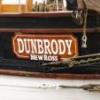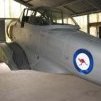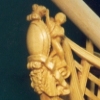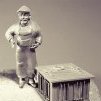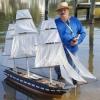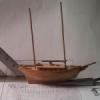Supplies of the Ship Modeler's Handbook are running out. Get your copy NOW before they are gone! Click on photo to order.
×
-
Posts
1,501 -
Joined
-
Last visited
Reputation Activity
-
 Mahuna got a reaction from Calhoun Zabel in Kathryn by Mahuna - FINISHED - 1:32 - Skipjack Based on HAER Drawings
Mahuna got a reaction from Calhoun Zabel in Kathryn by Mahuna - FINISHED - 1:32 - Skipjack Based on HAER Drawings
Part 53 – Pre-Rigging Work
The next major activity in the Kathryn build will be the installation of the boat’s railings, which are fairly complex. They will also be somewhat delicate, so there are a few items that should be completed before the railing work begins.
First is the Main Sheet Traveler. This is a 15” iron bar inserted as an inverted “U” just in front of the aft railings, as in the following photo.
It makes a lot more sense to install this traveler before the railing installation. The rigging associated with the traveler needs to be completed before installation.
There is a double block attached to the traveler by a ring and a shackle. On the other end, the sheet runs through a single block that will be hung from the boom by a hook that is attached to the block via a shackle. The loose length of the sheet is held on a cleat attached to the steering box.
The blocks used are the ‘internally stropped’ blocks from Syren. These blocks look very similar to the blocks currently in use on Kathryn.
The sheet was rigged through the blocks using the setup shown in the following photo.
After rigging the blocks the traveler was run through the ring attached to the lower block.
The traveler was then mounted through the deck planks in position behind the steering box.
The large cleat for managing the sheet was made of wood and mounted on the steering box.
The Jib Sheet Traveler has gone through some recent changes. The following photo shows the traveler as it is today, similar to the Main Sheet Traveler – an inverted “U”.
However, at the time of the HAER survey the traveler was a bar that was mounted against the log rails on the bow sides.
This configuration was still in place after the construction that was completed in 2015, as shown in the following photo from that time.
The traveler on the model is configured as it was during the HAER survey. The following photo shows the brass rod used for the traveler temporarily held in place by the mounting blocks for the traveller.
The Jib Sheet is rigged using two double blocks. From the deck level the sheet will be run through a block at the hounds and then back down to a cleat near the deck level, so a generous amount of rope was used for the sheet and coiled onto the deck for later use. The work setup for this rigging was the same as for the Main Sheet.
The traveler was installed by clamping the mounting blocks while the glue cured. (Any gluing that needed to be done over a painted surface was performed using Weldbond PVA, which provides a strong bond even on a painted surface.)
At this point in the construction it was also a good idea to mount the model on its permanent base, since waiting any longer for mounting would present a risk to the delicate work that will be done next.
There are a couple of other minor items that I wanted to get out of the way before working on the railings, but I’ve wasted a few days trying to make some very small components and have decided to put that aside for later and to begin installation of the railings, which will be the topic of the next post.
Thanks everyone!
-
 Mahuna reacted to EdT in Young America 1853 by EdT - FINISHED - extreme clipper
Mahuna reacted to EdT in Young America 1853 by EdT - FINISHED - extreme clipper
Thanks for these comments and likes.
Mark, the fastening you refer to is the heel lashing. It was made with a short length of rope between an eye or a hole in the boom to the jackstay or one of its stanchions. I believe topmen routinely carried a collection of small rope lengths for various uses - as well as the knife mentioned by Wefalck and other items. The two most obvious temporary lashings on my model are the boom heel lashings and the tied-off reef tackle blocks. Others were used in the various steps of bending or unbending sail.
To extend the boom, a boom-jigger tackle was attached to the inner end and to a point further out on the yard. The heel lashing was cut and the boom hauled out with that tackle where the inner end was again lashed down and the jigger removed. To retract, the process was reversed. In addition, when bending or unbending the yards' square sail, the studdingsail booms were unlashed at the inner end and that end hoisted up to clear the yard for the work of the yardmen. These types of temporary lashing were used routinely.
Studding sails were used infrequently and eliminated altogether in the later clipper years when speed was less of an issue. Setting these sails undoubtedly required some acrobatic efforts at the outer ends of the yards, but this work would normally be done in mild conditions. As modelers, we do not often think much about the order of setting and taking in sail, but a definite order was prescribed. Studding sails would be the last to be set as the wind died to near calm and the first to come down as it picked up - unlike, for example, reefing topsails - the last step as gale forces developed. This process also required a lot of knotting of reef points.
Iron men in wooden ships.
Ed
-
 Mahuna reacted to EdT in Young America 1853 by EdT - FINISHED - extreme clipper
Mahuna reacted to EdT in Young America 1853 by EdT - FINISHED - extreme clipper
Young America - extreme clipper 1853
Part 279 – Main Yard Stuns'l Booms
The main yard was fitted with the two topmast studdingsail booms. These supporedt the clews of the topmast studdingsails as well as the lower studdingsail yards that weresuspended from the ends of each when these sails were set. The booms were 42 feet long and 8 3/8" in diameter over their center sections. They taper to about 5 ¾" at the ends. All the drawing dimensions are expressed in full size decimals to permit easy conversion based on scale. The 1/72 converted sizes may be seen penciled on the drawing in the first picture.
The picture shows a finished boom and the "first trim" of the second – a squared length of Castello marked with centerlines and the two points at the ends pf the straight section. The boom is grooved for jewel blocks at the outboard end and drilled for a lashing at the inboard end. The inner hole was also used to fix a temporary tackle for hauling out the boom. The next picture shows a finished boom set in the boom irons in the retracted position.
The booms were shaped by the process described in earlier posts, then polished and finished with wipe-on polyurethane as described earlier. The next picture shows both booms lashed to jackstay stanchions at the inboard ends.
The next picture shows a close-up of a lashing.
I used untarred hemp for these and all lashings or fixings that would have been temporary. Because of the offset of the booms from the yard centerlines and the gradual taper of the yard, the booms are actually deflected somewhat to pull them fast to the stanchion. The last picture shows the end of the starboard boom after lashing on the two 9" jewel blocks.
The upper block handled the sheet for the topmast studding sail, the lower block the halyard for the lower stuns'l yard. The outer iron is sized for the diameter of the boom's center section.
Ed
-
 Mahuna got a reaction from Calhoun Zabel in Kathryn by Mahuna - FINISHED - 1:32 - Skipjack Based on HAER Drawings
Mahuna got a reaction from Calhoun Zabel in Kathryn by Mahuna - FINISHED - 1:32 - Skipjack Based on HAER Drawings
Part 52 – Kathryn’s Dredge Winder Cont’d
There are two pulleys hanging off either end of the dredge winder’s crossbar. The shape of these pulleys is fairly unique, so available blocks couldn’t be used and they needed to be fabricated. The following drawing shows the shape of these pulleys.
I tried making these out of brass, but the small size presented lots of problems so I decided to make them out of wood. The first step was gluing the drawing to an appropriately sized piece of wood.
The holes representing the size of the sheaves were drilled.
Then the outline of the pulley was shaped, first by cutting on the scroll saw and then by finishing with small files.
The groove representing the outside of the sheave was made using a small round escapement file.
A hole was drilled in the top of the pulley and a small ring made from copper wire was inserted and glued using CA.
The pulleys were hardened by soaking with thin CA, and were then finish-sanded. Black Rust-Oleum paint was sprayed on the pulleys while they were held by thin wire.
The pulleys were attached to the crossbar using small rings made from black wire.
The I-beams supporting Kathryn’s dredge winder are themselves supported by some wooden planks. On the model, these planks were drilled and then small pieces of .019 piano wire were glued into the holes to act as pegs for attaching the winder configuration to the model’s deck.
The planks with pegs were epoxied to the bottom of the I-beams. The blackening was scraped off the I-beams to ensure that the epoxy would hold.
Holes were drilled into the model’s deck to take the pegs. The following photo shows the winder configuration pegged to the deck, with the ‘cables’ for the dredge winders fed through the new pulleys.
The dredge winder is powered by a V-6 Buick engine contained in an engine housing. The following photos show the model’s engine housing in place. The exhaust pipe was made from 1/8” brass tubing colored with JAX Flemish Black diluted 1:1.
The dredge winder assembly will not be permanently mounted on the model until somewhat later in the build. Here are some photos of Kathryn’s current state.
There are a number of small items to be completed next, while I spend some time planning for the rest of the build.
Thanks everyone!
-
 Mahuna got a reaction from popeye the sailor in Kathryn by Mahuna - FINISHED - 1:32 - Skipjack Based on HAER Drawings
Mahuna got a reaction from popeye the sailor in Kathryn by Mahuna - FINISHED - 1:32 - Skipjack Based on HAER Drawings
Thanks Popeye.
-
 Mahuna got a reaction from PeteB in Kathryn by Mahuna - FINISHED - 1:32 - Skipjack Based on HAER Drawings
Mahuna got a reaction from PeteB in Kathryn by Mahuna - FINISHED - 1:32 - Skipjack Based on HAER Drawings
Part 52 – Kathryn’s Dredge Winder Cont’d
There are two pulleys hanging off either end of the dredge winder’s crossbar. The shape of these pulleys is fairly unique, so available blocks couldn’t be used and they needed to be fabricated. The following drawing shows the shape of these pulleys.
I tried making these out of brass, but the small size presented lots of problems so I decided to make them out of wood. The first step was gluing the drawing to an appropriately sized piece of wood.
The holes representing the size of the sheaves were drilled.
Then the outline of the pulley was shaped, first by cutting on the scroll saw and then by finishing with small files.
The groove representing the outside of the sheave was made using a small round escapement file.
A hole was drilled in the top of the pulley and a small ring made from copper wire was inserted and glued using CA.
The pulleys were hardened by soaking with thin CA, and were then finish-sanded. Black Rust-Oleum paint was sprayed on the pulleys while they were held by thin wire.
The pulleys were attached to the crossbar using small rings made from black wire.
The I-beams supporting Kathryn’s dredge winder are themselves supported by some wooden planks. On the model, these planks were drilled and then small pieces of .019 piano wire were glued into the holes to act as pegs for attaching the winder configuration to the model’s deck.
The planks with pegs were epoxied to the bottom of the I-beams. The blackening was scraped off the I-beams to ensure that the epoxy would hold.
Holes were drilled into the model’s deck to take the pegs. The following photo shows the winder configuration pegged to the deck, with the ‘cables’ for the dredge winders fed through the new pulleys.
The dredge winder is powered by a V-6 Buick engine contained in an engine housing. The following photos show the model’s engine housing in place. The exhaust pipe was made from 1/8” brass tubing colored with JAX Flemish Black diluted 1:1.
The dredge winder assembly will not be permanently mounted on the model until somewhat later in the build. Here are some photos of Kathryn’s current state.
There are a number of small items to be completed next, while I spend some time planning for the rest of the build.
Thanks everyone!
-
 Mahuna got a reaction from Canute in Kathryn by Mahuna - FINISHED - 1:32 - Skipjack Based on HAER Drawings
Mahuna got a reaction from Canute in Kathryn by Mahuna - FINISHED - 1:32 - Skipjack Based on HAER Drawings
Thanks Popeye.
-
 Mahuna got a reaction from thibaultron in Kathryn by Mahuna - FINISHED - 1:32 - Skipjack Based on HAER Drawings
Mahuna got a reaction from thibaultron in Kathryn by Mahuna - FINISHED - 1:32 - Skipjack Based on HAER Drawings
Thanks Popeye.
-
 Mahuna reacted to popeye the sailor in Kathryn by Mahuna - FINISHED - 1:32 - Skipjack Based on HAER Drawings
Mahuna reacted to popeye the sailor in Kathryn by Mahuna - FINISHED - 1:32 - Skipjack Based on HAER Drawings
a winch that detailed......definitely should be painted, blackened, weathered, and aged. it looks so good! nicely done Frank.....the winch is perfect!
-
 Mahuna got a reaction from EdT in Kathryn by Mahuna - FINISHED - 1:32 - Skipjack Based on HAER Drawings
Mahuna got a reaction from EdT in Kathryn by Mahuna - FINISHED - 1:32 - Skipjack Based on HAER Drawings
Part 52 – Kathryn’s Dredge Winder Cont’d
There are two pulleys hanging off either end of the dredge winder’s crossbar. The shape of these pulleys is fairly unique, so available blocks couldn’t be used and they needed to be fabricated. The following drawing shows the shape of these pulleys.
I tried making these out of brass, but the small size presented lots of problems so I decided to make them out of wood. The first step was gluing the drawing to an appropriately sized piece of wood.
The holes representing the size of the sheaves were drilled.
Then the outline of the pulley was shaped, first by cutting on the scroll saw and then by finishing with small files.
The groove representing the outside of the sheave was made using a small round escapement file.
A hole was drilled in the top of the pulley and a small ring made from copper wire was inserted and glued using CA.
The pulleys were hardened by soaking with thin CA, and were then finish-sanded. Black Rust-Oleum paint was sprayed on the pulleys while they were held by thin wire.
The pulleys were attached to the crossbar using small rings made from black wire.
The I-beams supporting Kathryn’s dredge winder are themselves supported by some wooden planks. On the model, these planks were drilled and then small pieces of .019 piano wire were glued into the holes to act as pegs for attaching the winder configuration to the model’s deck.
The planks with pegs were epoxied to the bottom of the I-beams. The blackening was scraped off the I-beams to ensure that the epoxy would hold.
Holes were drilled into the model’s deck to take the pegs. The following photo shows the winder configuration pegged to the deck, with the ‘cables’ for the dredge winders fed through the new pulleys.
The dredge winder is powered by a V-6 Buick engine contained in an engine housing. The following photos show the model’s engine housing in place. The exhaust pipe was made from 1/8” brass tubing colored with JAX Flemish Black diluted 1:1.
The dredge winder assembly will not be permanently mounted on the model until somewhat later in the build. Here are some photos of Kathryn’s current state.
There are a number of small items to be completed next, while I spend some time planning for the rest of the build.
Thanks everyone!
-
 Mahuna got a reaction from popeye the sailor in Captain Roy 1948 by russ - FINISHED - 1/48 scale - POB - Biloxi Lugger
Mahuna got a reaction from popeye the sailor in Captain Roy 1948 by russ - FINISHED - 1/48 scale - POB - Biloxi Lugger
Very nice work, Russ.
-
 Mahuna got a reaction from popeye the sailor in SHADOW by Omega1234 - FINISHED - Scale 1/300 - Luxury 60m Mega Yacht
Mahuna got a reaction from popeye the sailor in SHADOW by Omega1234 - FINISHED - Scale 1/300 - Luxury 60m Mega Yacht
That's another radical design! I'll be interested to see how you pull off the forward railing at your scale.
-
 Mahuna got a reaction from popeye the sailor in SHADOW by Omega1234 - FINISHED - Scale 1/300 - Luxury 60m Mega Yacht
Mahuna got a reaction from popeye the sailor in SHADOW by Omega1234 - FINISHED - Scale 1/300 - Luxury 60m Mega Yacht
Hi Patrick
I’m continually amazed at how much detail you can get into a tiny space. The little tender is awesome. (And I’m sure your garden is equally impressive - what scale is it?). 😉
-
 Mahuna got a reaction from popeye the sailor in Kathryn by Mahuna - FINISHED - 1:32 - Skipjack Based on HAER Drawings
Mahuna got a reaction from popeye the sailor in Kathryn by Mahuna - FINISHED - 1:32 - Skipjack Based on HAER Drawings
Thanks everyone for the 'Likes' and comments. It feels good to be back to work on Kathryn.
-
 Mahuna got a reaction from kees de mol in Kathryn by Mahuna - FINISHED - 1:32 - Skipjack Based on HAER Drawings
Mahuna got a reaction from kees de mol in Kathryn by Mahuna - FINISHED - 1:32 - Skipjack Based on HAER Drawings
Part 52 – Kathryn’s Dredge Winder Cont’d
There are two pulleys hanging off either end of the dredge winder’s crossbar. The shape of these pulleys is fairly unique, so available blocks couldn’t be used and they needed to be fabricated. The following drawing shows the shape of these pulleys.
I tried making these out of brass, but the small size presented lots of problems so I decided to make them out of wood. The first step was gluing the drawing to an appropriately sized piece of wood.
The holes representing the size of the sheaves were drilled.
Then the outline of the pulley was shaped, first by cutting on the scroll saw and then by finishing with small files.
The groove representing the outside of the sheave was made using a small round escapement file.
A hole was drilled in the top of the pulley and a small ring made from copper wire was inserted and glued using CA.
The pulleys were hardened by soaking with thin CA, and were then finish-sanded. Black Rust-Oleum paint was sprayed on the pulleys while they were held by thin wire.
The pulleys were attached to the crossbar using small rings made from black wire.
The I-beams supporting Kathryn’s dredge winder are themselves supported by some wooden planks. On the model, these planks were drilled and then small pieces of .019 piano wire were glued into the holes to act as pegs for attaching the winder configuration to the model’s deck.
The planks with pegs were epoxied to the bottom of the I-beams. The blackening was scraped off the I-beams to ensure that the epoxy would hold.
Holes were drilled into the model’s deck to take the pegs. The following photo shows the winder configuration pegged to the deck, with the ‘cables’ for the dredge winders fed through the new pulleys.
The dredge winder is powered by a V-6 Buick engine contained in an engine housing. The following photos show the model’s engine housing in place. The exhaust pipe was made from 1/8” brass tubing colored with JAX Flemish Black diluted 1:1.
The dredge winder assembly will not be permanently mounted on the model until somewhat later in the build. Here are some photos of Kathryn’s current state.
There are a number of small items to be completed next, while I spend some time planning for the rest of the build.
Thanks everyone!
-
 Mahuna got a reaction from PeteB in Kathryn by Mahuna - FINISHED - 1:32 - Skipjack Based on HAER Drawings
Mahuna got a reaction from PeteB in Kathryn by Mahuna - FINISHED - 1:32 - Skipjack Based on HAER Drawings
Thanks everyone for the likes and comments.
Ed - I use 62/36/2 Silver-Bearing Solder from Radio Shack. It's .015" diameter wire, so I can cut very small pieces. I also use Stay-Clean liquid flux.
The blackening of the winder was done with JAX Chemical's 'Pewter Black'. Most of the other metal components will be blackened with their "Brown Black" product, which gives a warmer black and won't be as stark. In the photos of Kathryn (and in real life) the blackness of the winder is striking, while the other components not so much. The winder was painted with Rust-Oleum gloss black the last time I saw it. I used the JAX Flemish Grey-Black, very diluted, on Kathryn's wheel and will likely use that in some diluted form where appropriate.
Patrick - thanks for the compliments, but the super-miniature work you do is already outstanding - so your skills and talent are already 110%!
-
 Mahuna got a reaction from Calhoun Zabel in Kathryn by Mahuna - FINISHED - 1:32 - Skipjack Based on HAER Drawings
Mahuna got a reaction from Calhoun Zabel in Kathryn by Mahuna - FINISHED - 1:32 - Skipjack Based on HAER Drawings
Part 51 – Kathryn’s Dredge Winder Cont’d
It has been quite a while since my last post. Here in Arizona, February and March are very popular months for visitors, and we had our share this year. So time in the shop has been hard to get for the past 6 weeks or so. I did mange to get a little done, and the last few days have been fairly productive.
The last photos showed the winder completed but still not blackened. The next photos show it after blackening (yes, I thought about leaving the brass natural, but I want to show Kathryn as she actually looks, so I needed to blacken the winder).
The dredges are hauled on cables, but metal cables would be difficult to wind around the winder drums, so black rope was used on the model instead. After winding the rope around the drums, matte medium was painted on the rope to keep it from loosening.
The frame around the dredge winder is constructed from angle iron. There is 1/16 and 1/8 brass angle iron available, but neither size was appropriate (I needed 3/32). So 1/32 was milled off each side of the 1/8 angle iron using the setup shown in the following photo.
The silver-colored clamps are homemade clamps that provide additional reach over the standard Sherline clamps.
The ends of the frame are constructed with angles rather than straight, and the ends are canted inward, as in the following construction drawing.
A wooden form was made to support the construction of the winder frame.
The angle on each side of the end pieces is 130 degrees, so the disk sander miter gauge was set at 65 degrees and the ends of the angle irons were sanded to this angle.
The end pieces of the form were removable to allow for clamping of the pieces.
Although the form is wood, it was able to withstand the resistance soldering which localizes the heat. This setup probably wouldn’t work very well for soldering with a torch.
Once the individual sides of the ends were soldered, the complete form was used to join all of the pieces to the crossbar.
In the above photo, a small hand vise is holding the form, and this small vise is being held in the bench vise.
The basic frame was completed, but still needed the cross-braces.
The soldering of the cross-braces required some extra effort to keep from opening the joints already soldered. Pieces of paper towel that had been soaked in water were clamped around existing joints to prevent the heat from opening those joints.
The following photos show the winder frame completed and blackened and temporarily in place. Additional work on the blackening is still needed.
Here’s a photo of Kathryn’s real winder and frame.
The pulleys hanging from the crossbar still need to be made, as well as the boards that are beneath the I-beams. The housing for the engine that drives the winder also needs to be made. The winder configuration will then be put aside until later in the project so it doesn’t interfere with other delicate construction work.
Thanks everyone. I hope to post more frequently now that work is again under way.
-
 Mahuna got a reaction from thibaultron in Kathryn by Mahuna - FINISHED - 1:32 - Skipjack Based on HAER Drawings
Mahuna got a reaction from thibaultron in Kathryn by Mahuna - FINISHED - 1:32 - Skipjack Based on HAER Drawings
Thanks everyone for the 'Likes' and comments. It feels good to be back to work on Kathryn.
-
 Mahuna reacted to dvm27 in Young America 1853 by EdT - FINISHED - extreme clipper
Mahuna reacted to dvm27 in Young America 1853 by EdT - FINISHED - extreme clipper
Terrific posting, Ed! It's amazing how well the wipe on poly resists smudging from alcohol and blackening solution. Blackening in place certainly solves the problem of damaging the metal finish during installation.
I note an additional iron band on the starboard yard plan that was not installed on the model (eighth from center). Illustration error?
-
 Mahuna reacted to EdT in Young America 1853 by EdT - FINISHED - extreme clipper
Mahuna reacted to EdT in Young America 1853 by EdT - FINISHED - extreme clipper
Young America - extreme clipper 1853
Part 278 – Completing the Main Yard
The first picture shows the main yard temporarily connected to the mast. Most of the ironwork has been fitted.
At his stage the yard was ready for the copper ironwork to be blackened. The brass-containing boom irons were pre-blackened before fitting. The next picture shows the removed yard and the ironwork being cleaned with isopropyl alcohol using a cotton swab.
The wipe-on poly base coat resists the alcohol and allows any smudges to be removed and the copper to be degreased. The next picture shows the yard after the liver of sulfur blackening process.
The blackening was done at the kitchen sink with tap water running. The yard and its fittings were liberally brushed with liver of sulfur solution and immediately rinsed under the tap. Any unblackened spots were re-brushed while wet and again rinsed. The yard was then allowed to dry. The next picture shows a closer view of the dried yard, taken the next day.
The straight, black wire shown in the last two pictures, is the jackstay rod. This was next slipped through the stanchions as shown in the next picture.
Straight .020" brass wire was used for this for its relative rigidity. It was pre-blackened using full strength Brass Black®. The eyebolts were spun from 28 gage copper wire. The fit is tight enough to keep the wire in place. In the last picture the jackstays have been inserted and clipped off.
The outer boom irons have also been fitted and a finish coat of satin wipe-on polyurethane applied, using a foam swab shown in the picture. The finish was "wiped" using a dry foam swab. The finish was applied to wood and iron alike.
Ed
-
 Mahuna got a reaction from mtaylor in Kathryn by Mahuna - FINISHED - 1:32 - Skipjack Based on HAER Drawings
Mahuna got a reaction from mtaylor in Kathryn by Mahuna - FINISHED - 1:32 - Skipjack Based on HAER Drawings
Thanks everyone for the 'Likes' and comments. It feels good to be back to work on Kathryn.
-
 Mahuna got a reaction from Canute in Kathryn by Mahuna - FINISHED - 1:32 - Skipjack Based on HAER Drawings
Mahuna got a reaction from Canute in Kathryn by Mahuna - FINISHED - 1:32 - Skipjack Based on HAER Drawings
Thanks everyone for the 'Likes' and comments. It feels good to be back to work on Kathryn.
-
 Mahuna got a reaction from JerryTodd in Kathryn by Mahuna - FINISHED - 1:32 - Skipjack Based on HAER Drawings
Mahuna got a reaction from JerryTodd in Kathryn by Mahuna - FINISHED - 1:32 - Skipjack Based on HAER Drawings
Part 52 – Kathryn’s Dredge Winder Cont’d
There are two pulleys hanging off either end of the dredge winder’s crossbar. The shape of these pulleys is fairly unique, so available blocks couldn’t be used and they needed to be fabricated. The following drawing shows the shape of these pulleys.
I tried making these out of brass, but the small size presented lots of problems so I decided to make them out of wood. The first step was gluing the drawing to an appropriately sized piece of wood.
The holes representing the size of the sheaves were drilled.
Then the outline of the pulley was shaped, first by cutting on the scroll saw and then by finishing with small files.
The groove representing the outside of the sheave was made using a small round escapement file.
A hole was drilled in the top of the pulley and a small ring made from copper wire was inserted and glued using CA.
The pulleys were hardened by soaking with thin CA, and were then finish-sanded. Black Rust-Oleum paint was sprayed on the pulleys while they were held by thin wire.
The pulleys were attached to the crossbar using small rings made from black wire.
The I-beams supporting Kathryn’s dredge winder are themselves supported by some wooden planks. On the model, these planks were drilled and then small pieces of .019 piano wire were glued into the holes to act as pegs for attaching the winder configuration to the model’s deck.
The planks with pegs were epoxied to the bottom of the I-beams. The blackening was scraped off the I-beams to ensure that the epoxy would hold.
Holes were drilled into the model’s deck to take the pegs. The following photo shows the winder configuration pegged to the deck, with the ‘cables’ for the dredge winders fed through the new pulleys.
The dredge winder is powered by a V-6 Buick engine contained in an engine housing. The following photos show the model’s engine housing in place. The exhaust pipe was made from 1/8” brass tubing colored with JAX Flemish Black diluted 1:1.
The dredge winder assembly will not be permanently mounted on the model until somewhat later in the build. Here are some photos of Kathryn’s current state.
There are a number of small items to be completed next, while I spend some time planning for the rest of the build.
Thanks everyone!
-
 Mahuna got a reaction from herask in Kathryn by Mahuna - FINISHED - 1:32 - Skipjack Based on HAER Drawings
Mahuna got a reaction from herask in Kathryn by Mahuna - FINISHED - 1:32 - Skipjack Based on HAER Drawings
Part 52 – Kathryn’s Dredge Winder Cont’d
There are two pulleys hanging off either end of the dredge winder’s crossbar. The shape of these pulleys is fairly unique, so available blocks couldn’t be used and they needed to be fabricated. The following drawing shows the shape of these pulleys.
I tried making these out of brass, but the small size presented lots of problems so I decided to make them out of wood. The first step was gluing the drawing to an appropriately sized piece of wood.
The holes representing the size of the sheaves were drilled.
Then the outline of the pulley was shaped, first by cutting on the scroll saw and then by finishing with small files.
The groove representing the outside of the sheave was made using a small round escapement file.
A hole was drilled in the top of the pulley and a small ring made from copper wire was inserted and glued using CA.
The pulleys were hardened by soaking with thin CA, and were then finish-sanded. Black Rust-Oleum paint was sprayed on the pulleys while they were held by thin wire.
The pulleys were attached to the crossbar using small rings made from black wire.
The I-beams supporting Kathryn’s dredge winder are themselves supported by some wooden planks. On the model, these planks were drilled and then small pieces of .019 piano wire were glued into the holes to act as pegs for attaching the winder configuration to the model’s deck.
The planks with pegs were epoxied to the bottom of the I-beams. The blackening was scraped off the I-beams to ensure that the epoxy would hold.
Holes were drilled into the model’s deck to take the pegs. The following photo shows the winder configuration pegged to the deck, with the ‘cables’ for the dredge winders fed through the new pulleys.
The dredge winder is powered by a V-6 Buick engine contained in an engine housing. The following photos show the model’s engine housing in place. The exhaust pipe was made from 1/8” brass tubing colored with JAX Flemish Black diluted 1:1.
The dredge winder assembly will not be permanently mounted on the model until somewhat later in the build. Here are some photos of Kathryn’s current state.
There are a number of small items to be completed next, while I spend some time planning for the rest of the build.
Thanks everyone!
-
 Mahuna got a reaction from cog in Kathryn by Mahuna - FINISHED - 1:32 - Skipjack Based on HAER Drawings
Mahuna got a reaction from cog in Kathryn by Mahuna - FINISHED - 1:32 - Skipjack Based on HAER Drawings
Thanks everyone for the 'Likes' and comments. It feels good to be back to work on Kathryn.


